
Sign up for a new account.
And get access to
The latest T1D content
Research that matters
Our daily questions
Sign up by entering your info below.
Reset Your Password
Don't worry.
We will email you instructions to reset your
password.
We’re celebrating 2 years of the T1D Exchange Registry!
For the 2nd anniversary of the Registry, we want to show our entire community the impact that so many people with type 1 diabetes (T1D) have made by sharing their experiences. Over the past two years we’ve gathered the stories of nearly 15,000 people to better understand how people with T1D are doing collectively, and potentially identify trends and improve the future of T1D care.
If you are not familiar, the T1D Exchange Registry is a long-term research study open to adults and children with T1D living in the United States. The Registry aims to give a snapshot of how people with T1D are doing and identify what can improve. Participants complete a questionnaire once per year and can participate in other optional T1D research studies through their Registry Dashboard.
Not yet part of the T1D Exchange Registry? Join us!
We’re kicking off our Registry insights campaign by looking at device usage and health outcomes such as:
- Insulin pump usage in different age groups
- CGM usage in different age groups
- Average A1c of insulin pump users and non-users
- Average A1c of current continuous glucose monitor (CGM) users, past CGM users and non-users
- Rate of insulin pump usage by duration of T1D
DISCLAIMER: All data presented below is only representative of participants in the T1D Exchange Registry. This data does not indicate any causation in its current format, but rather presents the Registry data as it exists in June 2021.
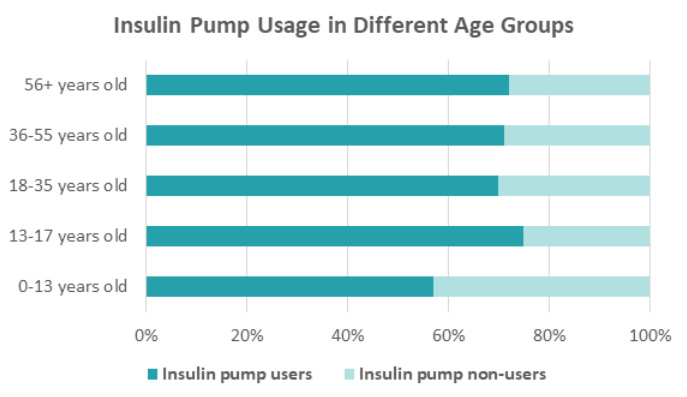
In the Registry, what percentage of people in different age groups wear an insulin pump?
- 0-13 years old: 57%
- 13-17 years old: 75%
- 18-35 years old: 70%
- 36-55 years old: 71%
- 56+ years old: 72%
The lowest rate of insulin pump usage in the Registry is among children under age 13, whereas the closest age group of teenagers 13-17 years old had the highest percentage of pump users. Beyond age 13, the insulin pump usage rate is consistent throughout the other age groups in the 70-75% range.
Participants in the Registry are people who have chosen to engage with T1D research. They may be more likely to adopt and access new technologies than the general T1D population.
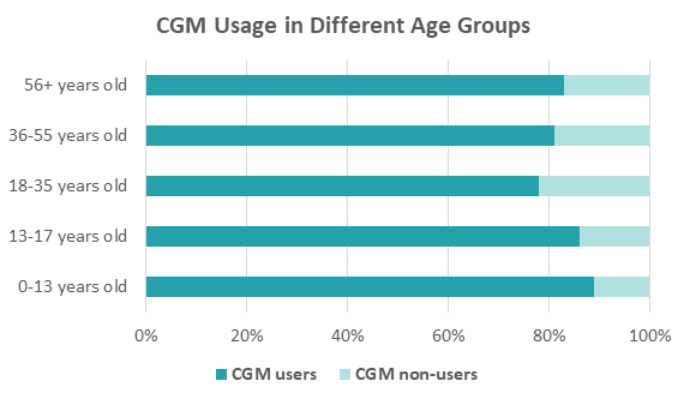
In the Registry, what percentage of people in different age groups use a CGM?
- 0-13 years old: 89%
- 13-17 years old: 86%
- 18-35 years old: 78%
- 36-55 years old: 81%
- 56+ years old: 83%
In contrast to the previous insight, the age group with the highest rate of CGM usage in the Registry is children under 13 years old. Even though younger adults ages 18-35 have the lowest rate of CGM usage, still more than three-quarters of this group use a CGM.
Overall, the rate of CGM usage in the Registry is substantially higher than insulin pump usage.
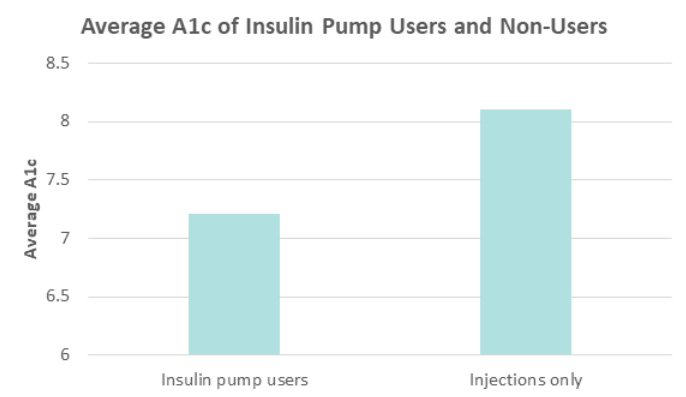
In the Registry, what is the average A1c of people who use an insulin pump and those who do not?
- Insulin pump users: 7.21%
- Injections only: 8.10%
The difference between the average A1c for insulin pump users and non-users is roughly 0.9%.
This Registry data is consistent with recent T1D Exchange studies from our Quality Improvement Collaborative that show that insulin pump usage is associated with maintaining target blood glucose levels.
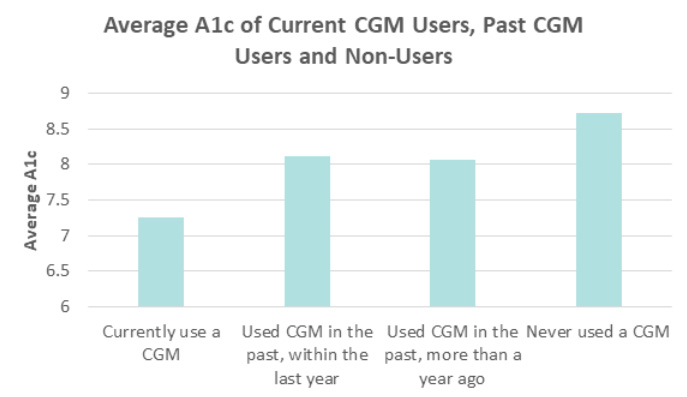
In the Registry, what is the average A1c of people who use a CGM, those who have used one in the past, and those who have never?
- Currently use a CGM: 7.25%
- Used to use a CGM within the past year: 8.12%
- Used to use a CGM, more than a year ago: 8.06%
- Never used a CGM: 8.73%
This insight from the Registry shows that the average A1c is much lower for participants who use a CGM compared to those who do not. There is a wide difference in A1c levels between those who currently use a CGM and those have never used a CGM of nearly 1.5%.
This Registry insight is again consistent with recent T1D Exchange studies from our Quality Improvement Collaborative that show that CGM usage is associated with maintaining target blood glucose levels.
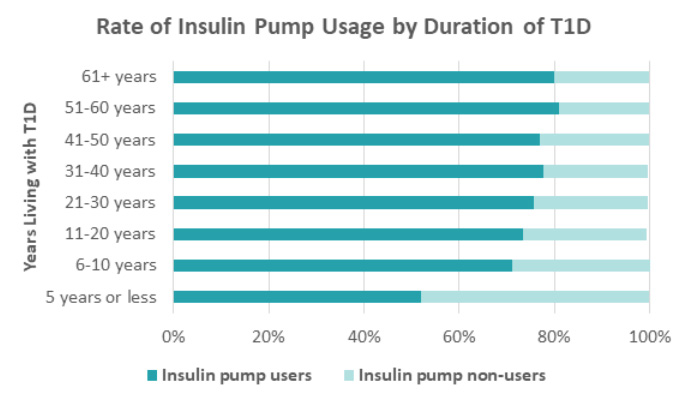
In the Registry, what is the rate of insulin pump usage in groups of people who have lived with T1D for different lengths of time?
- T1D for 5 years or less: 52.1%
- T1D for 6-10 years: 71.2%
- T1D for 11-20 years: 73.5%
- T1D for 21-30 years: 75.7%
- T1D for 31-40 years: 77.6%
- T1D for 41-50 years: 77.3%
- T1D for 51-60 years: 81.4%
- T1D for 61+ years: 80.2%
The lowest rate of insulin pump usage is among those who have been diagnosed with T1D within the past 5 years. The most notable difference between groups is between people who were diagnosed within the past 5 years and people who have had T1D for 6-10 years, with a 19% difference between the two groups.
Among people who have lived with T1D for 6 or more years, the rate of insulin pump usage varies between the groups by approximately 10%.
Over the coming weeks, we’ll be sharing more insights from the T1D Exchange Registry at T1DExchange.org and on Instagram (@T1DExchange)!
And if you haven’t already, join the T1D Exchange Registry today and add your story to ours!
Sarah Howard
Related Stories
4 Comments
Celebrating 2 Years of the T1D Exchange Registry Cancel reply
You must be logged in to post a comment.








I am wondering if you have a further breakdown of male and female for all of the categories shown.
I’m a bit confused about this “2 year anniversary” celebration. The T1D Exchange has been around since at least 2014.
In 2018, the T1D Exchanged published the article “State of Type 1 Diabetes Management and Outcomes from the T1D Exchange in 2016–2018.”
https://www.ncbi.nlm.nih.gov/pmc/articles/PMC7061293/
This article is important because it shows that the Pump vs. MDI (multiple daily injections) method isn’t as simple as portrayed on this page. While younger kids do benefit from Pumps, the real difference is not in the pump, it’s in whether you use a CGM. In fact, A1c outcomes are better (marginally) in people >26 years old using MDI, not pumps, provided they also use a CGM.
Other studies show much more nuanced differences between pump vs. non-pump users.
In fact, the BEST outcomes are from people who use bluetooth insulin pens (which record injections into diabetes management apps) because the doing data combines with the CGM data for the best possible outcomes. See the article, 12 Diabetes Problems That New “Smart” Insulin Pens Can Solve: https://www.healthline.com/diabetesmine/diabetes-how-smart-insulin-pens-help
WhenI was diagnosed with T1D in 1973, I was told my my doctor I would never see my 30th birthday & I would be blind before I died. It has been miraculous to see all the advances I’ve seen. I turned 66 the beginning of 2021 and I’m looking forward to see what’s coming next. I have worn an Insulin pump and sensor for over 22 years. I still check my blood sugar manually several times a day. Some tell me I over do it but I work hard to keep my A1C under control. I have no sign of kidney failure & I work hard to prevent it.